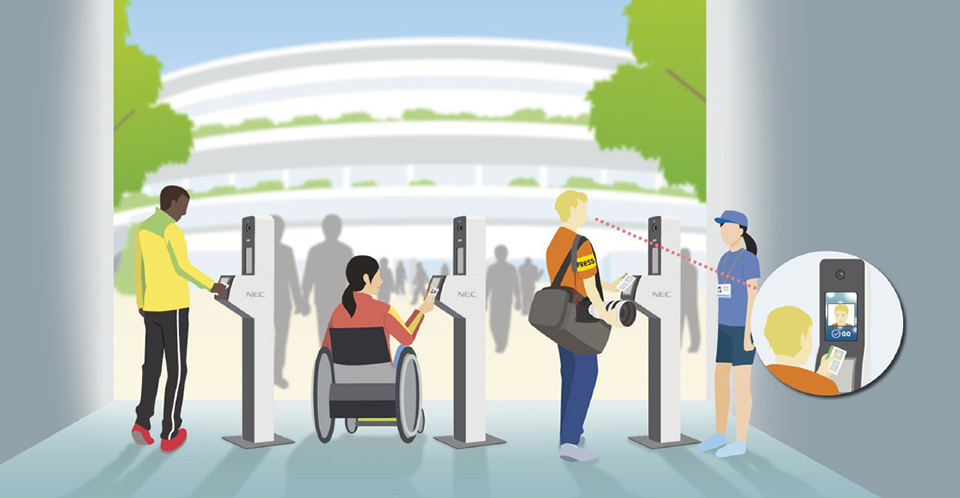With AI facial-recognition systems and autonomous patrolling security robots, the Olympic and Paralympic Games Tokyo 2020 are geared up and ready to go with state-of-the-art Japanese technology

ID card theft and misuse can be immediately detected because people’s identities can be accurately verified through collating information from their ID cards with the facial-recognition system.

Narita International Airport uses facial recognition at customs. It is available for those with a biometric passport (embedded IC chip).
While the world’s top athletes train hard in a bid to win medals at the Olympic and Paralympic Games Tokyo 2020, preparations are underway in Tokyo for a safe and secure event. One of the most ground-breaking measures to be used during the Tokyo 2020 Games is the facial-recognition ID system that has been implemented to identify the faces of officials and athletes, granting them access into the venues. The system, provided by NEC Corporation, one of the world’s leading companies in facial-recognition technology, will allow approximately 300,000 athletes, officials, volunteers and media representatives access to restricted areas. It will be the first time in the history of the Olympic and Paralympic Games that this kind of facial-recognition system will be used to verify the identity of Games officials and authorized people.
The Tokyo 2020 Games will not have an Olympic Park per se; instead events will be held in locations frequented by many people, alongside the hustle and bustle of big-city Tokyo life, so a system that can quickly and effectively grant access to restricted areas, and only for those authorized, is a major challenge. In order to overcome such a problem, this facial-recognition system, which is able to verify the identity of individuals from a database of 1.6 million images with an extremely high level of accuracy in only 0.3 seconds, has been adopted. Beginning with fingerprint verification, NEC has been researching biometric identification and developing technologies for nearly 50 years. “Numerous facial feature points are converted into data and matched to give an almost instantaneous identification. Deep learning in artificial intelligence improves accuracy levels leading to extremely low error rates[1]. And because the data is encrypted and cannot be reconstructed, individual facial images can never be leaked,” says YAMAGIWA Masahiro, senior manager for Public Safety and Network Business Promotion Office at NEC.
The company’s facial-recognition technology is being used in immigration at airports in many countries around the world, and has also been used at customs in Terminal 3 of Narita International Airport. If passengers register their information using the app and scan the app at the airport kiosk, then the facial recognition system allows for smooth entry into the country.

Four security robots are operating at Narita International Airport. The robots maneuver by themselves among airport users while giving the warning “patrolling.”

Another new technology that plays a big role at Narita, Japan’s gateway to the skies, is the autonomous patrolling surveillance robot. The Secom Robot X2, rolled out in June this year, has the technology to navigate around the airport terminal. Not only can the robot take 360-degree video using an omnidirectional camera, but it is also equipped with a thermal imaging sensor and metal detector, which can be used by extending the robotic arm to check for suspicious objects in trash cans and detect heat. Security surveillance carried out by robots has many advantages, not least of which is the capability to perform operations without ever losing concentration. “It’s a security surveillance system that complements both human and robotic skills, with a part where people are better and a part where the robot is better,” explains OZA Koichi from the R&D Center at Secom Co., Ltd.

The REBORG-Z with a large built-in display. It can also display emergency evacuation advice in multiple languages during a disaster.
In addition to such airport security, throughout Tokyo, there are also many assistance-providing robots. This can be seen, for example, in the autonomous security robot REBORG-Z. Built by the security company Sohgo Security Services Co., Ltd.(ALSOK), REBORG-Z has a large built-in touch panel, security cameras and sensors, which can provide information to visitors in different languages, as well as security, as it maneuvers inside and outside of buildings. “Security guards are expected to play a variety of roles, and providing assistance in and around their place of work is one of the most important of these,” says TSUNETSUGU Sou from the R&D Planning Division at ALSOK.
The Tokyo 2020 Games aim to be the most innovative Olympics and Paralympics to date. From airports to sporting venues, innovative Japanese technology is helping to provide an environment where everyone can enjoy the Games with peace of mind.
[1] Ranked 1st in the National Institute of Standards and Technology’s latest face-recognition technology benchmark test, with a recognition error rate of 0.5% for 12 million still images.





























